A Revolution in cricket pitch management?
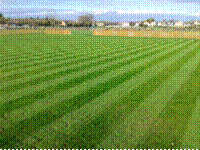
Regeneration may have become a development buzzword, and recycling a daily part of domestic life but, when it comes to the improvement of sports pitches, both are relatively new concepts. Here, we take a look at a project that’s underway at Olney Town Cricket Club, and which aims to save the club not only money, but valuable time.
This quandary faced Iain James, Club Secretary at Buckinghamshire side Olney Town Cricket Club, when looking to install three new natural turf match pitches and a non-turf match pitch, whilst simultaneously improving the condition of the ground’s entire square, last year. Iain says: “We’ve seen increased participation at Olney Town CC, particularly in our youth section, and also host a number of corporate fixtures due to our location. Whilst this is all great for the club, it meant that the seven pitches on our square were simply no longer sufficient. For this reason, we wanted to expand from seven to ten natural pitches, and also install a non-turf pitch.”
“However, we also believe that better facilities have a role to play in developing better cricketers, so we wanted to improve the performance of the entire square by reducing thatch content, removing saddles and improving pitch levels. The aim was always to keep the impact of any works on the playing season to a minimum, so we were keen to find a solution that would enable us to play up to the end of the 2012 season and, if possible, use the majority of the square in summer 2013.”
Bridging the gap …
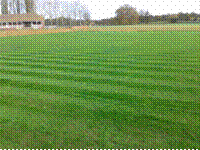
Cricket surface specialist, total-play Ltd, was invited to put forward a proposal for the work following a successful project at the club in winter 2011, when it resurfaced an existing concrete based non-turf practice facility. Following investigative works on site, MD David Bates proposed a solution aimed at achieving the club’s objectives, as he explains: “Given the issues presented by the surface, and the fact that new pitches were to be installed, simple square restoration works didn’t fit the bill. On the other hand, the target timescales – and the fact that the club had a limited budget – meant the construction of a completely new square was out of the question. Instead, we recommended a process to ‘bridge the gap’ between the two; which effectively regenerates and recycles the existing pitch profile.”
“We were aware of a similar project being undertaken successfully at the SWALEC Stadium in Cardiff a few years ago, but it’s certainly not common practice. I’ve always considered it to be potentially a great solution, although many factors need to be taken into account before going down this route, and it just happened to fit the bill at Olney. Iain was interested in what we proposed, and the rest is history.”
“Works commenced in September 2012 and were completed within two weeks. We then provided the club with a recommended maintenance schedule and have kept a close eye on progress over the winter months. There are some general maintenance tasks to complete in spring, but it looks like we are on target for the table to be in full use this summer.”
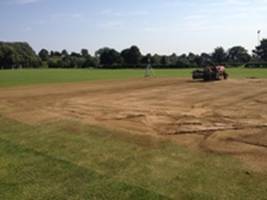
Putting theory into practice
To establish the full extent of works required at Olney Town CC, an in-depth survey was first undertaken, with the following key issues identified:
– Existing square ‘plateaued’ approximately 60-80mm above surrounding playing area
– Profile showed layering to a depth of 70-80mm, with 10mm of organic matter
– Lack of density to vertical rooting of the grass plant
– Root breaks and discontinuations within and between profile layers
– Excessive build-up of organic matter, or ‘thatch’, on surface
– Severe ‘saddling’ on existing seven natural pitches
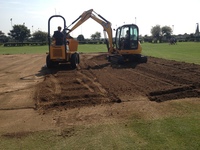
As it stood, the existing square’s surface levels ranked ‘average’ and fell within the minimum standards benchmarked by the ECB’s Performance Quality Standards (PQS). There was, however, significant room for improvement; not only in terms of performance in the benchmarking tables but in the playing experience.
Key objectives:
– To remove thatch from the site to speed up play, aid surface drainage and reduce risk of pest and disease problems
– To encourage vertical rooting down to at least 150mm to help hold the soil together and produce a faster, more consistent and higher bouncing

– Introduce an imported soil to the recycled profile in order to improve the quality of the loam, with the aim of creating a soil with a breaking strength of between 56-75kg to ensure it holds together in the event of drying out
– To establish an improved sward of 100% Perennial Ryegrass, the preferred species for cricket pitches
– To provide a playing surface with levels that rank well in the PQS benchmarking system
Site preparation
Prior to work commencing on site, a laser level was set up to control laser guided equipment, and the levels cross-referenced to ensure accuracy at every stage of the process. To rectify the issues highlighted by the report, organic matter was initially removed from the table by fraise mowing, with spoil placed on site and retained for use in recycling process.
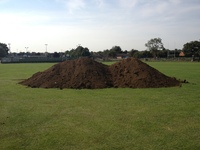
Profile Recycling
The existing profile was cultivated and then broken down further before the formation layer was graded to establish consistent surface levels across the whole area.
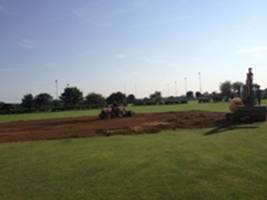
Surface Grading
Once cultivated, the surface was levelled and compacted using a laser guided grader for accuracy. At this stage, the only imported element of the new profile – Boughton County Loam – was introduced to help improve the native soil. The introduced material was ameliorated into the existing profile using a combination of mechanical and hand raking.
The seedbed was then prepared by further mechanical and hand raking to produce a fine tilth; with extra care taken to maintain a level, smooth and evenly firmed seedbed with a final surface tolerance level of +/-3mm.
Application of seed and fertiliser
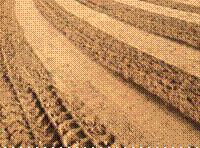
To establish a better sward and, in turn, enhance the playing experience, a 100% Perennial Rye Grass seed mix – selected from the STRI grass ratings to suit the local climatic conditions, soil type, the club’s maintenance programme, performance requirements and existing cultivars – was applied to the graded seedbed. The seed was sown evenly using a cyclone distributor at a rate of 60g/m².
A 6:9:6 fertiliser was then applied, using a cyclone distributor at a rate of 35g/m², before being lightly raked into the surface along with the seed, with extra care taken to maintain an even coverage and avoid the creation of ridges in the final surface levels.
Outfield/square interface
Along with the above works, a new interface between the square and outfield was created to provide a gentle slope for the bowlers’ run-up. To do this, the on-site soil excavated during works was used and oversown with Perennial Ryegrass seed.
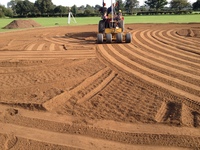
Construction of new match pitches
Alongside the above regeneration work, three new natural grass pitches were constructed from scratch, with the same mix of imported and recycled material from the existing square used to ensure a seamless fit across the entire table. A non-turf match pitch, built to total-play’s ECB approved tp365 design, was also constructed alongside the square, with the immediate area around it graded and left to establish with soil and seed.
Ongoing maintenance
With the new surface seeded, initial maintenance was handed over to the club, with the overriding goal being to ensure moisture content remained tightly controlled during winter to allow the newly regenerated profile the best chance of establishing for the season ahead.
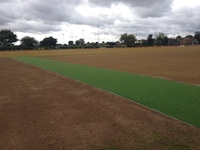
Typically unpredictable autumn weather meant the germination situation was closely monitored – a complete lack of rain in the first ten days after seeding caused particular concern, as temperatures were beginning to drop. However, after the first rainfall the seed cracked and everything was back on course. Over the past few months, the club has cut the square a few times and total-play is set to return to site, once weather conditions are optimum, to carry out the initial rolling of wickets and a low-rate overseed to thicken up the grass sward in conjunction with spring fertilisation.
The club will continue to monitor the square, checking for disease and establishment of the sward, prior to the pre-season pitch preparation that will start once the weather improves. Members are looking forward to seeing how this new process performs in the long-term, as Iain explains: “To undertake a complete square renovation at a club with only one ground is a large risk, and we had to ensure that we had good grass cover before the winter set in. We worked hard with total-play to do this. Now, our challenge is to produce good pitches from year one and look for improvement in pitches through years two and three.”
Profile Regeneration & Recycling: The Theory
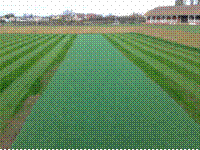
The ‘compactability’ of soil is considered to be an important factor in the selection of cricket loams, yet compaction is detrimental to the health of grasses used in general for sports surfaces. It results in the total exclusion of vital pore spaces in the soil horizons that hold moisture, air and to allow root development to depth.
In cricket, we are looking to ‘consolidate’ the soil which, although similar to compaction, differs in that pore spaces are retained -although smaller – allowing for air and water retention and promoting deep root development.
Pore space is related to the range of particle sizes within the soil; soils are said to be ‘well sorted’ (all similar-sized particles) or ‘well graded’ (a variety of particle sizes). Consolidation of soil particles into a tight packing arrangement markedly increases the bulk density of the soil – but decreases its porosity – therefore producing the firmer surfaces required in cricket.
Soil structure refers to the arrangement of soil particles into aggregates, which possess solids and, more importantly, pore spaces. Aggregates are important in soils because they influence bulk density, porosity and pore size. Different pore sizes, large and small, provides for good aeration, permeability and water-holding capacity. Aggregates in different forms give the soil its structure, and naturally occurring events aid the formation of aggregates, including:
• Wetting and drying
• Freezing and thawing
• Microbial activity that aids in the decay of organic matter
• The activity of roots and soil organisms
• Absorbed cations
When a soil becomes destructured, few or none of these events can occur naturally and, if they do, it takes many years. Compaction, leading to destructured surfaces, is a common result of cricket surface preparation over several years, and this loss of soil structure invariably requires expensive remediation, traditionally in the form of replacement, rejuvenation or re-surfacing.
Deciding on the best route forward
To decide on the best remedial route, a thorough investigation of the cricket facility is required. The investigation should be carried out by someone who can interpret the results and implications of a variety of factors; including soil type, particle size distribution, bulk density, moisture content, clay mineralogy, nutrient status, pH, layering, thatch and fibre content and overall pitch construction, amongst others.
Two of the most important things to consider are clay content and clay type. Clay content, as noted by the England & Wales Cricket Board (ECB) TS4 document Recommended Guidelines for the construction, preparation and maintenance of cricket pitches and outfields at all levels of the game should be for:
– First Class and Premier Leagues: minimum of 28-35% clay
– Club standard: minimum of 25-30% clay
– School: minimum of 25-28% clay
The ‘organic’ fraction in cricket loams, meanwhile, should be between 2-8% with a pH above 5.5.
There are a number of different types of clay; Kaolonite and Smectite being two of the main types when discussing clay soils for cricket. A single clay particle is referred to as a ‘colloid’ and, depending on the type of clay, is made up of ‘layers’ or ‘sheets’. These layers can be 1:1 (Kaolinite), 2:1 (Micas, Illite, Vermiculite and Montmorillonite) or 2:1:1 (Chlorite) which refers to the ‘bonding’ agent between layers, for example hydrogen, aluminium etc. This whole chemical process is a very complex subject that would take too much time to explain in full here, but it has a bearing on the final decision. Likewise, another important factor about clays is they carry a negative ionic charge and, therefore, attract positive ions, which also needs to be considered.
The shrink/swell characteristic of clays is also important because of surface cracking on cricket pitches; it can make clays incompatible and be one of the causes of layering. It is, therefore, important to establish whether different clays are compatible when considering changing topdressings. This should also be kept in mind when deciding to remove the surface of worn out cricket pitches; would the replacement cricket loam be compatible with the indigenous soil in the lower horizon?
All of these factors play a critical role in deciding the best course of remedial action to breathe life back into an under-performing pitch; be it replacement, rejuvenation or re-surfacing.
Profile Regeneration & Recycling: an alternative solution?
By combining a hybrid of surface restoration and pitch construction works, and re-using as much on-site material as possible, profile regeneration and recycling aims to offer a cost and time-efficient solution compared to traditional remedial works, particularly where layering is not a problem.
One key benefit is that the ‘history’ of the indigenous material is known, whereas with introduced screened manufactured loams, for example, you would not necessarily know and it could be very expensive to find out. The biggest advantage, however, of recycling indigenous material is cost; the soil will cost nothing, but any introduced materials have to be paid for; particularly screened, manufactured loams, which can be very expensive by comparison. There are also minimal costs associated with the removal and disposal of unwanted native material.
Another benefit of the regeneration and recycling process is that it results in an immediate improvement to performance, and will enable the square to be used the following season; thereby avoiding the delays often associated with full construction works. In short, a combination of profile regeneration and recycling works can breathe life back into old squares – creating the equivalent of a newly constructed table at a fraction of the cost and playing down-time.
Limitations & Risks
Despite its obvious attractions, profile regeneration and recycling is by no means a ‘fix all’ solution. Its viability very much depends on the state of the existing table, the depth of work required to bring the profile up to scratch and the native soil types.
The regeneration side of the process is restricted to a depth of 80-100mm; if problems with levels and profile layering go deeper than this on a site, it is likely that full reconstruction of the table will be the best solution.
In profile recycling, the native soil type will influence what, if any, imported materials are required to be added to the existing profile to provide a surface that will consolidate sufficiently and encourage the growth of a sward suited to cricket, such as 100% Perennial Ryegrass. Again, in a case where the soil type is particularly ill-suited, the best solution may well be to start from scratch and reconstruct the square traditionally using imported materials.
Alongside these fundamental considerations, timescales also need to be meticulously planned to ensure that the square has sufficient time to establish ahead of the new playing season, with mitigation in place to minimise potential disruption and delay due to weather and other external factors.
